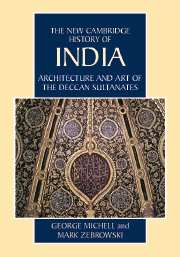Book contents
- Frontmatter
- Introduction
- 1 Historical framework
- 2 Forts and palaces
- 3 Mosques and tombs
- 4 Architectural decoration
- 5 Miniature painting: Ahmadnagar and Bijapur
- 6 Miniature painting: Golconda and other centres
- 7 Textiles, metalwork and stone objects
- 8 Temples
- 9 Conclusion
- Appendix: Dynastic Lists of Deccan Rulers
- Bibliographic Essay
- Bibliography
- Index
- Map of the Southern Deccan"
- Plate Section"
9 - Conclusion
Published online by Cambridge University Press: 28 March 2008
- Frontmatter
- Introduction
- 1 Historical framework
- 2 Forts and palaces
- 3 Mosques and tombs
- 4 Architectural decoration
- 5 Miniature painting: Ahmadnagar and Bijapur
- 6 Miniature painting: Golconda and other centres
- 7 Textiles, metalwork and stone objects
- 8 Temples
- 9 Conclusion
- Appendix: Dynastic Lists of Deccan Rulers
- Bibliographic Essay
- Bibliography
- Index
- Map of the Southern Deccan"
- Plate Section"
Summary
Having separately considered the most significant examples of Deccani courtly and religious architecture, miniature paintings, textiles and metal objects, it is now necessary to evaluate the overall character of these buildings and works of art. The discussions in the preceding chapters have defined a profusion of distinctive artistic modes that emerged between the fourteenth and eighteenth centuries. This stylistic multiplicity may be singled out as an overriding characteristic of Deccani art. That these divergent but concurrent idioms should coincide with the sponsorship of different lines of rulers is hardly surprising, considering the dominant role of sultans and their nobles, commanders and governors in the political and cultural life of the region. Architectural and pictorial styles follow dynastic careers, underscoring the interdependency of art and patronage in this era.
Another, no less representative trait that runs through the descriptions of Deccani architecture and painting is the constant relationship to North Indian and Middle Eastern traditions. In the course of these stylistic borrowings, foreign modes were transformed in order to create new and intrinsically Deccani idioms. This stylistic metamorphosis seems not to have been restricted to a single moment in Deccani history; to the contrary, it was an on-going process that responded creatively to both invasion and influence from outside the region.
- Type
- Chapter
- Information
- Architecture and Art of the Deccan Sultanates , pp. 268 - 272Publisher: Cambridge University PressPrint publication year: 1999

